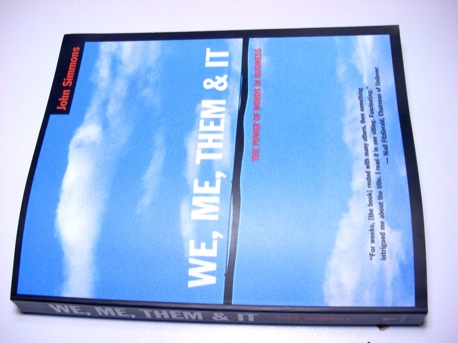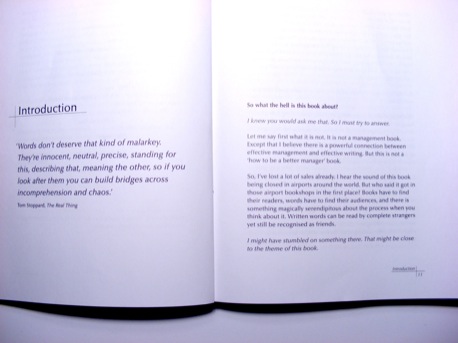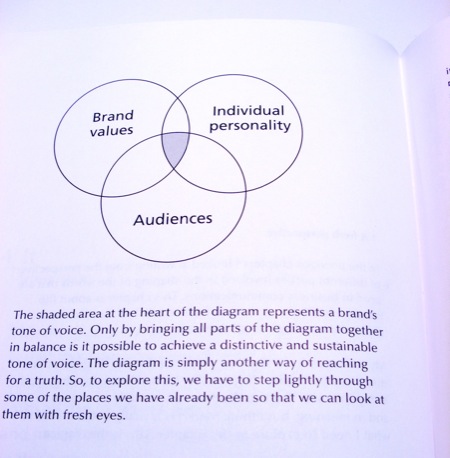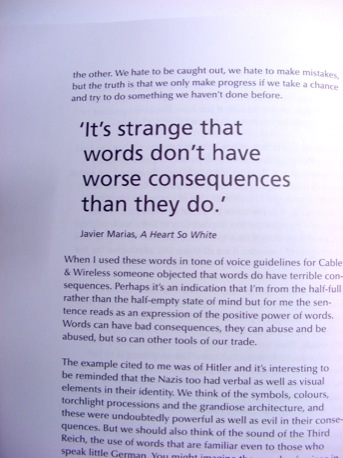We, Me, Them & It

We, Me, Them & It by John Simmons can be summed up by an endorsement on its front cover:
“For weeks, [the book] rested with many others, then something intrigued me about the title. I read it in one sitting. Fascinating.” - Niall FitzGerald, Chairman of Unilever
Though a rewarding book due to the description of how Simmons approaches writing, as well as the book’s tone, the potential to have it sitting on your bookshelf for weeks is real, because, it is such an ugly book. There is little initial incentive to pick it up.
(Click to enlarge)
The book’s presentation creates a list of problems: subtitles are indiscernible from the main text as they are only slightly bigger than an already big font; it has an extremely basic layout, as though it was complied entirely in MS Word and apart from the from cover, the entire book is printed in black and white. Even being just a writer, I am a little disappointed that the book’s concern is with the content of message and does not think about its presentation.
The bad aesthetics do not matter when actually reading the book page by page, but, when flicking through it for quotes and referencing the lack of distinctive pages mean that it is becoming a little torturous to use.
The title We, Me, Them & It sets out the chapters of the book, and reflects the four things which Simmons believes an author of business copy should consider when writing. ‘We’ investigates the importance of the company’s overall tone. ‘Them’ relates to the audience, ‘It’ the effectiveness of the message itself, and ‘Me’ the belief that the authors own personality should not be removed from the copy.
For good, interesting writing, Simmons says ‘it’ should incorporate a little bit of all four elements.
(Click to enlarge)
The book places its main effort into encouraging an author’s personal voice into writing. Simmons describes his main day to day role as trying to ‘persuade others to be less inhibited in their writing.’ Simmons successfully demonstrates what a less ‘inhibited writer’ is, with mixed results.
The majority of book is written in a easy to read and friendly tone. There is little diversion from this tone as Simmons inserts transcripts of speeches he has made to groups of employees, and extracts of letters written to businesses which have employed him to work on their brand language. Progressing through the book, this constant easy to get on with style not only pulls you in, but also makes Simmons very persuasive in the points he makes.
This is reinforced with witty quotes from other writers, like Dennis Potter’s ‘The trouble with words is you never know whose mouths they’ve been in’ or Ogilvy’s ‘People who think well, write well’. All quotes support his point that good writing is critical to good business and sometimes goes further that good writing is a judgement of a good characteristic.
Simmons does at two points in the book complete misjudge the tone and content by publishing extracts of personal letters which refer to vaguely to difficult periods of his life (the meat of the issues are edited out). This is the first book I have read by Simmons, and if you follow what I believe a good read/author relationship should be, that it should have the same decorum as a first encounter with someone. The personal extracts make for a heavy, uncomfortable atmosphere out of place with the rest of the book.
(Click to enlarge)
But, I am pleased to say that other exercises where Simmons takes lead to encourages to place you into the practise of using a personal tone are more successful in keeping with the rest of the book.
One of the more original ideas involved Simmons taking a group of volunteers and assigned each of them a poem. They were asked to read it daily and think carefully about what was written. Simmons describes the aims to be two fold: firstly to ‘bring more of the inner person to work’, and secondly, is about ‘finding, or creating, the time and space to think.’ Through creating time to think, Simmons argues, means breaking writing habits and unlocking creativity.
The results of the exercise listed participants relating what was written to their everyday lives. While it seems that it did not change the volunteers working habits drastically, the section argues well the effectiveness of writing on the conscience, especially if it strikes the right tone.
(Click to enlarge)
With the book finished, I am still thinking how to evaluate the book. While I have warmed to Simmons’ style of writing, I want to lean towards describing this book as being a mans description to how he believes copy should be, whilst allowing enough room for experiment for it not to feel to a reader as a ridged sermon.
But, if you consider the social proofing quote by a chairman on the front cover, the fact that most transcripts within the book were originally directed to a group writers rather than individuals, as well as a dogged focus on message rather than message and presentation; I cannot remove the thought that this book was never intended for individuals writers like myself, but instead to wake up company CEOs and MDs about the importance of brand language, baiting them into employing Simmons’ company.
We, Me, Them & It by John Simmons is published by McArthur & Company and available directly on Amazon (US|CA|UK|DE) or via The Designer’s Review of Books Amazon store.
About the Reviewer
Peter Winnicki is an au courant London based writer. A literary and language obsessive. Follow him on Twitter under @peterwinnicki or find him on his personal website.





